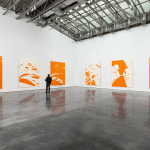
Selected by Sharon Butler / From the press release for her recent solo at Bortolami: Marina Rheingantz is an artist who picks apart and unravels topology into its loosest forms. She references tapestries, carpets, textiles, forests, mountains, soccer fields, skate parks, excavation sites; anyplace where one might traverse. She takes notes with her camera to frame specific elements of landscapes but, in her paintings, embeds fragmented memories of real and imagined locales. As one plane bleeds into another, the horizon line loses its relevance. Her compositions are all ground and no sky, or the landscapes risk becoming too real or familiar. Rheingantz’s work exudes a thick, humid atmosphere, and her vision suggests a dystopian future; her environments are deserted, abandoned, and have given way to ruin and overgrowth. Her construction sites are defined only by their stakes and outlines, frozen and incomplete.


The monumental scale of Rheingantz’s paintings belie their intimacy. Her detailed brushstrokes and careful scraping render structures that appear as small as maquettes on a carpeted floor or as large as a building site in a barren expanse. Pisador, the painting whose title names the small rectangle of fabric upon which one steps before sleep, blends textile with terrain. Palm trees and tall grass blur into the milky froth of a dreamscape. And Varzea, in which the ruins and remnants of human activity dissolve into a flood-soaked field, again, transforms into a carpet, whose fabric then weaves and sprouts into a pitch. The multiple perspectives and planes in the painting allude to the double meaning of “varzea” in Portuguese, both forested seasonal floodplain and tricky situation. Jorro, Portuguese for a spurt or stream, depicts a muddied fountain that vacillates between water feature and tree with the haze and fog of a lush forested landscape sublimated in paint.


Layers of paint accrue over months. She does not set out with a particular narrative in mind, rather the painting itself dictates how she might assemble the work. She builds them up to sand them down and scrape away; pressing her medium through the linen weave like a sieve. She excavates her canvases, exposing their strata, and relegates the remnants — the deposits — to the edges where she wipes her palette knives clean. Favoring dense layers and thick impasto over flatness, she searches for the materiality of her medium. The heavy gobs of paint on the surface could be mistaken for pure happenstance, but they are improvisational, happening in the moment and dictated by the process itself.
Marina Rheingantz (b. in 1983 in Araraquara, SP) has held solo shows at Centro Cultural Sao Paulo (2012) and at Centro Universitrio Maria Antonia (2011), among others. Her participation in group shows includes Projeto Piau (at Pive Arte e Pesquisa, Sao Paulo, 2016), Soft Power (Kunsthal KAdE Amersfoort, the Netherlands, 2016), Os Muitos e o Um (The Many and the One at Instituto Tomie Ohtake, Sao Paulo, 2016), and No Man’s Land, Women Artists from the Rubell Family Collection (Contemporary Arts Foundation, Miami, 2015). Her work can be found in collections such as the Pinacoteca do Esado de Sao Paulo, Museu de Arte Moderna de Rio de Janero, and Ital Cultural. Marina Rheingantz is represented by Fortes D’Aloia & Gabriel, Sao Paulo, Brazil and Zeno X, Antwerp, Belgium.

”Varzea: Marina Rheingantz,” Bortolami, Tribeca, New York, NY. Through June 2, 2018.
Related Posts:
Triangular: Andrew Seto and Deborah Dancy
VERNACULAR: A painterly conversation about abstraction























Thank you for introducing me to this artist. Incredible and powerful work. Wish I had gotten in to see in person.
No exagero pero pienso que Marina Rheingantz es hoy por hoy la pintora mas asombrosa que existe… Muchos museos o galer�as del mundo ya deber�an notar eso